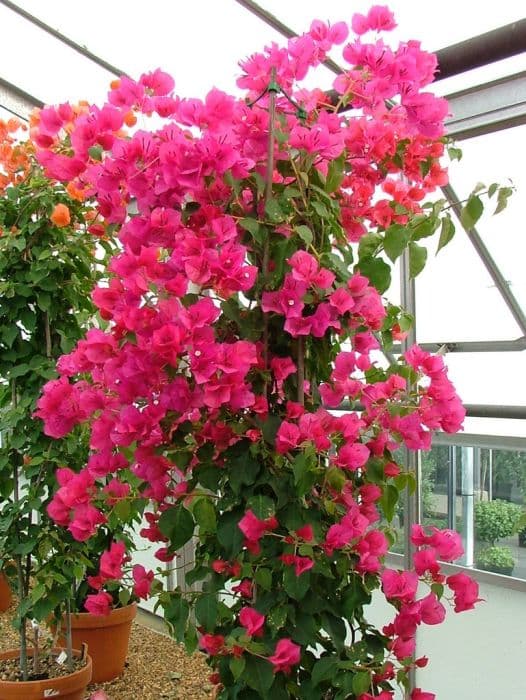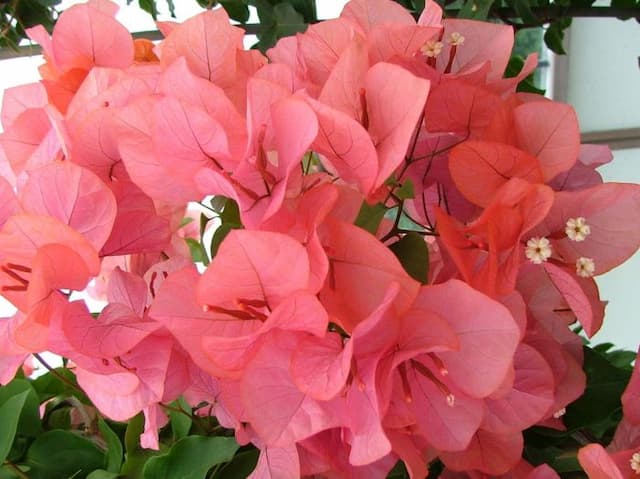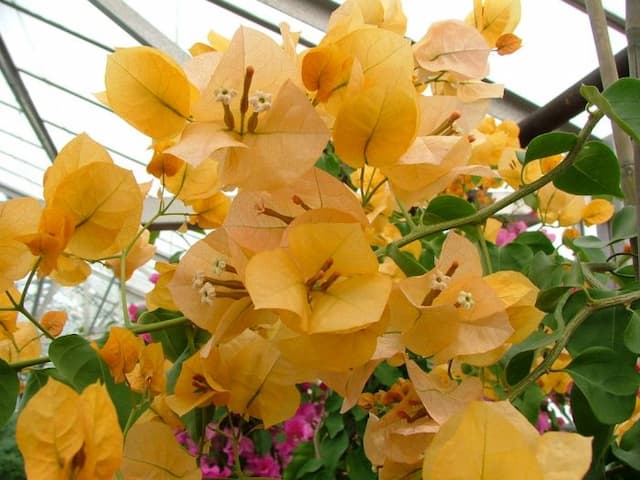Bougainvillea (Spectoperuviana Group) 'Mary Palmer's Enchantment'

ABOUT
Mary Palmer's Enchantment is a variety of Bougainvillea notable for its striking visual appeal. This plant boasts vibrant bracts, which are modified leaves that surround the plant's small, white flowers. These bracts appear in delightful shades of pink and white, creating an enchanting contrast against the green foliage. As the common term for these colorful bracts, "flowers" is often used colloquially to describe them, even though they are not the true flowers of the plant. The foliage of Mary Palmer's Enchantment is lush and dense, with leaves that have a slightly leathery texture and are dark green in color. They are typically oval-shaped with pointed tips, which together forms a rich backdrop for the colorful bracts. Bougainvilleas, including this variety, are known for their thorny vines, which is an aspect new gardeners should be aware of, as the sharp spines can be quite prominent. What makes Mary Palmer's Enchantment stand out among Bougainvillea varieties is primarily its vivid bract coloration and the abundant display that can cascade over walls, trellises, or other supportive structures in the garden. When in its flowering season, this plant can become a central feature in a landscape, drawing eyes and admiration for its ornamental beauty. The visual impact of Mary Palmer's Enchantment makes it a popular choice for those looking to add a touch of charm and vibrancy to their outdoor spaces.
About this plant
 Names
NamesSynonyms
Paper Flower, Bougainvillea.
Common names
Bougainvillea spectoperuviana 'Mary Palmer's Enchantment'.
 Toxicity
ToxicityTo humans
Bougainvillea is not highly toxic to humans, but it can cause skin irritation and its sharp thorns may cause puncture wounds. Ingesting parts of the bougainvillea, such as the flowers or leaves, can result in gastrointestinal discomfort including nausea, vomiting, and diarrhea. Care should be taken to avoid contact with the thorns and to prevent ingestion of the plant parts, especially by children.
To pets
Bougainvillea is also not highly toxic to pets, but it can be irritating to them as well. In the event that a pet ingests part of a bougainvillea, it might experience gastrointestinal upset, which could include symptoms such as vomiting or diarrhea. The plant's thorns may also cause injury if a pet comes into contact with them. It is advisable to keep pets away from bougainvillea to prevent any accidental ingestion or injuries from the thorns.
 Characteristics
CharacteristicsLife cycle
Perennials
Foliage type
Evergreen
Color of leaves
Green
Flower color
Pink
Height
15-40 feet (4.6-12.2 meters)
Spread
5-8 feet (1.5-2.4 meters)
Plant type
Climber
Hardiness zones
9
Native area
South America
Benefits
 General Benefits
General Benefits- Aesthetic Appeal: The Bougainvillea 'Mary Palmer's Enchantment' offers vibrant and colorful blooms, which can enhance the beauty of gardens, patios, and landscapes.
- Heat Tolerance: This plant thrives in hot climates, making it an excellent choice for warm regions and sunny locations.
- Drought Resistance: Once established, bougainvilleas are relatively drought-tolerant, requiring minimal watering and conserving water resources.
- Versatility: It can be trained to grow in various forms, such as shrubs, trees, or climbing vines, suitable for different garden designs and spaces.
- Privacy Screen: When used as a hedge or climbing vine, bougainvilleas can create a dense screen, offering privacy and reducing noise pollution.
- Long Blooming Period: Bougainvilleas, including 'Mary Palmer's Enchantment,' can bloom for a significant part of the year, providing long-lasting color and interest.
- Wildlife Attraction: The plant can attract pollinators like bees and hummingbirds, contributing to the local ecosystem's health.
- Low Maintenance: Once established, it requires minimal care, making it suitable for gardeners with limited time.
 Medical Properties
Medical PropertiesThis plant is not used for medical purposes.
 Air-purifying Qualities
Air-purifying QualitiesThis plant is not specifically known for air purifying qualities.
 Other Uses
Other Uses- Bonsai: Bougainvillea can be trained to grow as a bonsai, requiring diligent pruning and care to maintain its miniature size and shape.
- Natural Dye: The bracts of the plant can be used to produce natural dyes for fabric, though the colorfastness may vary.
- Ink Making: The vibrant colors of Bougainvillea, particularly the deep magenta and purples, can be used to create natural inks for art purposes.
- Erosion Control: Bougainvillea can be planted on slopes to help stabilize the soil and prevent erosion due to their extensive root system.
- Privacy Screens: When grown densely, Bougainvillea can form an effective natural privacy screen for homes and gardens.
- Topiary: The sturdy vines of Bougainvillea can be shaped into various forms to create living sculptures in the garden.
- Photography Backdrop: The lush and colorful foliage along with the abundant flowers can provide a striking natural backdrop for photography.
- Thermal Insulation: When grown against walls, the dense foliage of Bougainvillea can help insulate buildings, reducing the need for heating or cooling.
- Sound Barrier: Thick hedges of Bougainvillea can help reduce noise pollution by absorbing and deflecting sound waves.
- Wedding Decor: Bougainvillea branches and flowers are often used in wedding decorations for their bright colors and association with good luck.
Interesting Facts
 Feng Shui
Feng ShuiThe Bougainvillea is not used in Feng Shui practice.
 Zodiac Sign Compitability
Zodiac Sign CompitabilityThe Bougainvillea is not used in astrology practice.
 Plant Symbolism
Plant Symbolism- Passion and Beauty: Bougainvillea is a symbol of passion and beauty due to its vibrant and attractive blooms, which add a burst of color and energy wherever they grow.
- Resilience and Survival: Known for its ability to thrive in harsh conditions, bougainvillea represents resilience and the capacity to survive and flourish against the odds.
- Welcoming: Often used in gardens and entryways, this plant is seen as a sign of welcome, inviting guests with its lush, colorful presence.
- Warmth: The bright hues of the bougainvillea flower are reminiscent of tropical climates and sunny weather, symbolizing warmth and a sunny disposition.
 Water
WaterBougainvilleas, including 'Mary Palmer's Enchantment', prefer deep, infrequent watering to encourage a strong root system. Water the plant thoroughly until excess water drains out of the bottom of the pot, then allow the top inch of the soil to dry out before watering again. In hot weather, this might mean watering once a week; in cooler weather, every few weeks might suffice. Stick your finger into the soil to check for moisture before deciding to water. Typically, 1-2 gallons will be adequate for a mature plant in a large container during each watering session, depending on the size of the plant and the environmental conditions.
 Light
LightBougainvillea, including 'Mary Palmer's Enchantment', thrives in full sun for optimal growth and bloom. Place the plant in a location where it can receive more than 6 hours of direct sunlight daily. An east or west-facing spot that receives ample morning or afternoon sunlight is ideal, but a south-facing location is usually the best to ensure it gets the amount of light it loves.
 Temperature
TemperatureBougainvillea 'Mary Palmer's Enchantment' performs well in warm temperatures, ideally between 60°F and 100°F. It should be protected from frost and will not survive temperatures below 30°F. The best range for bougainvillea growth is 70°F to 85°F during the day. Make sure to bring the plant indoors or protect it from cold drafts and freezes to prevent damage.
 Pruning
PruningPrune 'Mary Palmer's Enchantment' bougainvillea after blooming to shape the plant and promote more flowers. The best time to prune is in late winter or early spring before new growth begins. Prune selectively to remove dead wood and to thin out crowded areas, as bougainvillea blooms on new growth. Trim the plant back to control size as desired, but avoid heavy pruning which can reduce blooming.
 Cleaning
CleaningAs needed
 Soil
SoilBougainvillea prefers well-draining soil with added organic material like peat moss or compost. A mixture of two parts peat or compost to one part perlite or coarse sand is ideal, encouraging good drainage and aeration. They thrive in a slightly acidic to neutral pH, ranging from 5.5 to 6.5.
 Repotting
RepottingBougainvillea should be repotted every 2-3 years, or when they become root-bound. Younger plants may need more frequent repotting, while mature bougainvilleas can be repotted less often.
 Humidity & Misting
Humidity & MistingBougainvilleas prefer moderate humidity but are adaptable to a range of conditions. They can withstand dry air but appreciate occasional misting or a pebble tray with water if the environment is very dry.
 Suitable locations
Suitable locationsIndoor
Place in bright, direct light; prune for size control.
Outdoor
Full sun; well-draining soil; protect below freezing.
Hardiness zone
9-11 USDA
 Life cycle
Life cycleBougainvillea 'Mary Palmer's Enchantment', commonly known simply as Bougainvillea, begins its life as a seed, germinating in warm, well-draining soil with ample sunlight. After sprouting, the seedling grows into a young plant with characteristic thorny stems and heart-shaped leaves. As it matures, it enters a vigorous growth phase, where it rapidly expands in size and may require support or training if grown as a vine. Flowering occurs in cycles throughout the warmer months, producing vibrant colored bracts that surround the true flowers, which are small and white. After pollination, the plant can produce tiny, dry fruits containing seeds, completing the reproductive cycle. Over many years, with proper care, Bougainvillea 'Mary Palmer's Enchantment' can become a large, woody perennial, demonstrating robust growth with seasonal pruning to encourage blooming and maintain desired shape.
 Propogation
PropogationPropogation time
Spring-Early Summer
The most popular method of propagating Bougainvillea, specifically the 'Mary Palmer's Enchantment' variety, is through stem cuttings. This is typically done during the warm seasons, spring through summer, when the plant is actively growing. To propagate, a healthy, non-flowering stem about 4 to 6 inches (approximately 10 to 15 centimeters) long is cut just below a node. The lower leaves are removed, and the cut end is dipped in a rooting hormone to stimulate root growth. The prepared cutting is then inserted into a well-draining potting mix, ensuring at least one node is below the surface. The container is placed in a warm, bright spot out of direct sunlight, and the soil is kept consistently moist but not overly wet. With proper care, roots will develop within a few weeks, at which point the new Bougainvillea plant can gradually acclimate to more direct light and less frequent watering.
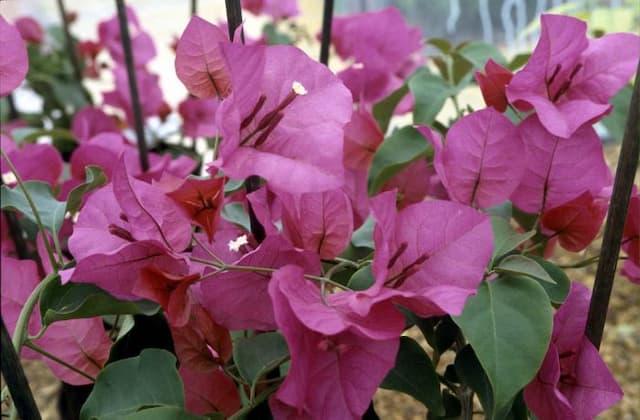
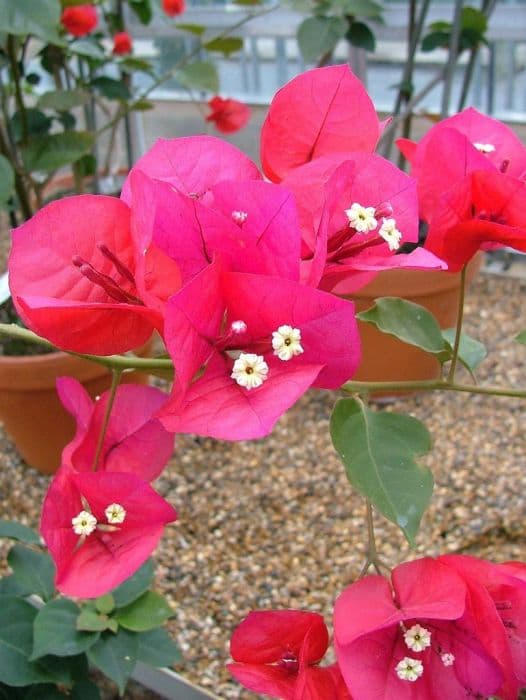
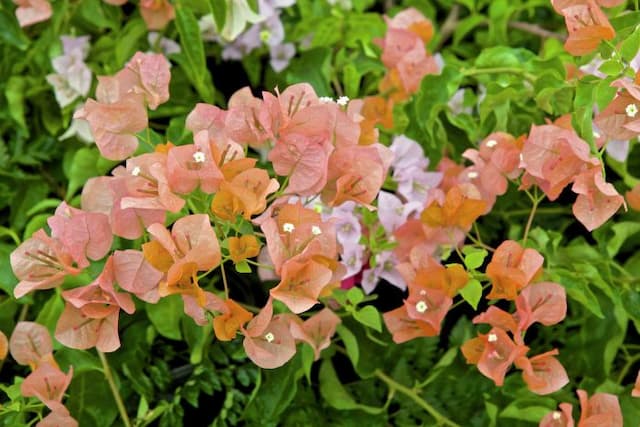
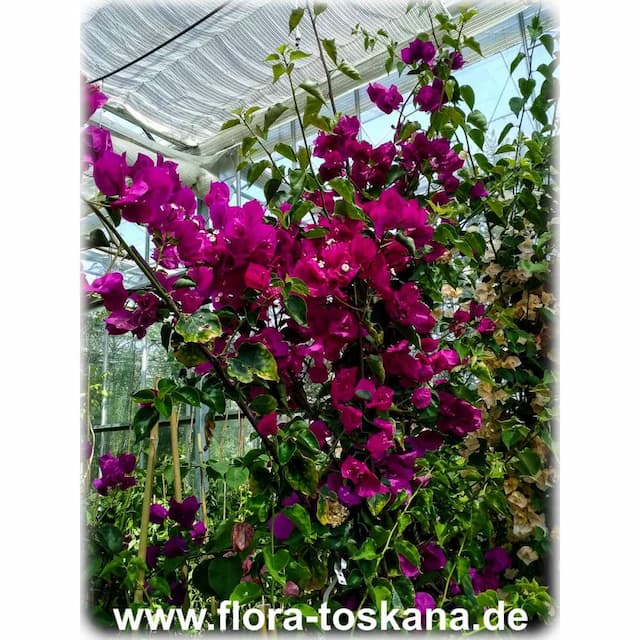
![Bougainvillea [Texas Dawn]](/_next/image?url=https%3A%2F%2Fplants-admin.emdemapps.com%2Fimages%2Fplants%2F%2Fimages%2F604b5f2598081.png&w=640&q=75)
